BUSINESS IN THE LONG AGO IN
RANDOLPH COUNTY, ARKANSAS
Welcome to Business In The Long Ago in Randolph County, Arkansas. It appears that these photos were originally published in the Pocahontas Star Herald around 1968-70, but are much, much older than that. Remember that you can use your special "find" or "search" button on your toolbar to look for surnames - and be sure that you check different spelling variations. So ... sit back ... scroll down ... and enjoy ...
Return to Randolph County Homepage

A photo, taken inside the bank of Maynard, has recently been
published and there was some question as to the opening date of
that bank. Mrs. Lena Redwine Abbott of 6619 Mardel Avenue,
St. Louis, MO., who furnishes the above photo, reports that the
bank opened for business in 1900, and the above photo was taken
on the opening day. Her father, the late T. Jesse Redwine
and Mrs. Abbott are standing in the teller's window of the bank.
Mr. Redwine was the first cashier of the bank and his
daughter, Lena, worked with him.

Mrs. Jesse W. Burrow of Rt. 2, Pocahontas, furnishes this
interesting photo of the blacksmith shop belonging to her father,
the late Birb Stevens, at Warm Springs, about 1912. In the
photo Mr. Stevens is shoeing a wild mule with the assistance of
Si Bailey, who is holding a twist on the mule's nose in an
attempt to keep the animal still. Other men in the photo
are, from left, Ples Carter, Rufe Harris, and Rufe Shipman.
In the buggy, just behind the mule being shod, is Alfred
Harris. The store in the center background is that of Mose
Burrow, a mercantiler. A store building belonging to Benton
Holt now stands at the same site. The building in the right
background is the old Dalton Store. The building later
burned and Mr. Stevens built a store in the site. Close
scrutiny reveals a house just past the latter store, belonging to
Mrs. Dona Gordon Friar. Mrs. Friar operated a telephone
switchboard in her home, and each phone patron paid $1 per month
on her salary. The phone reached to nearby communities, and
as far away as Ingram. In dire emergencies, people could
call Ingram citizens and the Ingramite would then call Pocahontas
to relay a message. As roads were bad and travel slow, the
telephone system certainly served an important purpose, although
it was sometimes difficult to hear a speaker on the other end of
the line. As late as 1890, Warm Springs was still a popular
spa, with visitors coming from near and far to bathe in or drink
from the 60 or more warm medicinal springs which were sometimes
compared to the famous chalybeate Vicy waters of Europe. By
the time the above photo was made the fame of the springs had
subsided and the village was beginning its decline.
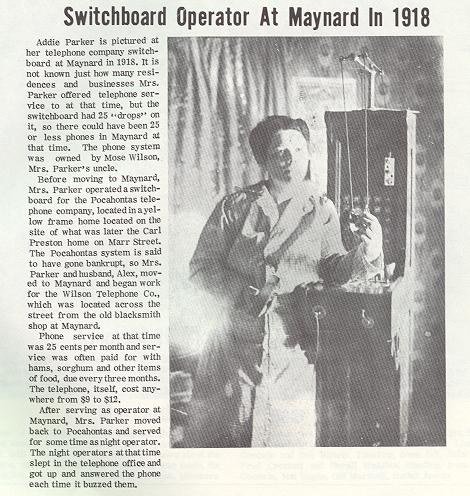
Addie Parker is pictured at her telephone company switchboard at
Maynard in 1918. It is not known just how many residences
and businesses Mrs. Parker offered telephone service to at that
time, but the switchboard had 25 "drops" on it, so
there could have been 25 or less phones in Maynard at that
time. The phone system was owned by Mose Wilson, Mrs.
Parker's uncle. Before moving to Maynard, Mrs. Parker
operated a switchboard for the Pocahontas telephone company,
located in a yellow frame home located on the site of what was
later the Carl Preston home on Marr Street. The Pocahontas
system is said to have gone bankrupt, so Mrs. Parker and her
husband, Alex, moved to Maynard and began work for the Wilson
Telephone Co., which was located across the street from the old
blacksmith shop at Maynard. Phone service at that time was
25 cents per month and service was often paid for with hams,
sorghum and other items of food, due every three months.
The telephone, itself, cost anywhere from $9 to $12. After
serving as operator at Maynard, Mrs. Parker moved back to
Pocahontas and served for some time as night operator. The
night operators at that time slept in the telephone office and
got up and answered the phone each time it buzzed them.
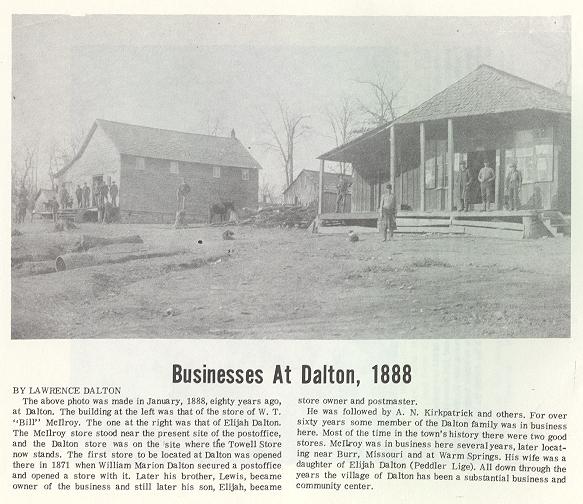
The above photo was made in January, 1888, eighty years ago, at
Dalton. The building at the left was that of the store of
W. T. "Bill" McIlroy. The one at the right was
that of Elijah Dalton. The McIlroy store stood near the
present site of the postoffice, and the Dalton store was on the
site where the Towell Store now stands. The first store to
be located at Dalton was opened there in 1871 when William Marion
Dalton secured a postoffice and opened a store with it.
Later his brother, Lewis, became owner of the business and still
later his son, Elijah, became store owner and postmaster.
He was followed by A. N. Kirkpatrick and others. For over
sixty years some member of the Dalton family was in business
here. Most of the time in the town's history there were two
good stores. McIlroy was in business here several years,
later locating near Burr, Missouri and at Warm Springs. His
wife was a daughter of Elijah Dalton (Peddler Lige). All
down through the years the village of Dalton has been a
substantial business and community leader.
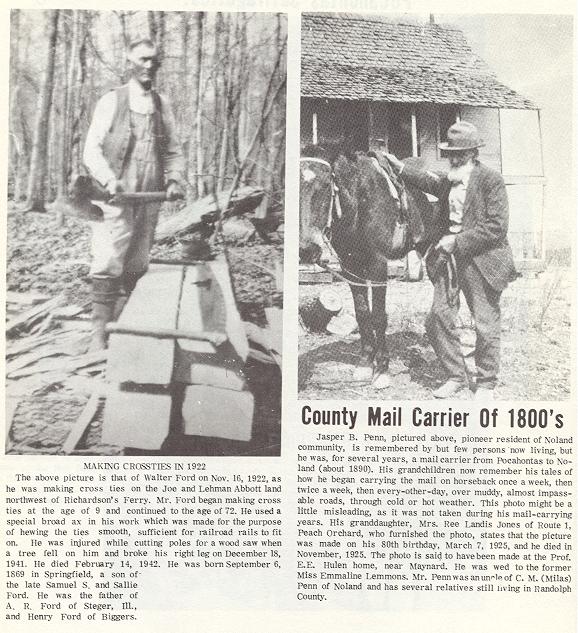
LEFT PHOTO - The above picture is that of Walter Ford on Nov. 16,
1922, as he was making cross ties on the Joe and Lehman Abbott
land northwest of Richardson's Ferry. Mr. Ford began making
cross ties at the age of 9 and continued to the age of 72.
He used a special broad ax in his work which was made for the
purpose of hewing the ties smooth, sufficient for railroad rails
to fit on. He was injured while cutting poles for a wood
saw when a tree fell on him and broke his right leg on December
18, 1941. He died February 14, 1942. He was born
September 6, 1869 in Springfield, a son of the late Samuel S. and
Sallie Ford. He was the father of A. R. Ford of Steger,
Ill., and Henry Ford of Biggers.
RIGHT PHOTO - Jasper B. Penn, pictured above, pioneer resident of Noland community, is remembered by but few persons now living, but he was, for several years, a mail carrier from Pocahontas to Noland (about 1890). His grandchildren now remember his tales of how he began carrying the mail on horseback once a week, then twice a week, then every-other-day, over juddy almost impassable roads, through cold or hot weather. This photo might be a little misleading, as it was not taken during his mail-carrying years. His granddaughter, Mrs. Ree Landis Jones of Route 1, Peach Orchard, who furnished the photo, states that the picture was made on his 80th birthday, March 7, 1925, and he died in November, 1925. The photo is said to have been made at the Prof. E. E. Hulen home, near Maynard. He was wed to the former Miss Emmaline Lemmons. Mr. Penn was an uncle of C. M. (Milas) Penn of Noland and has several relatives still living in Randolph County.
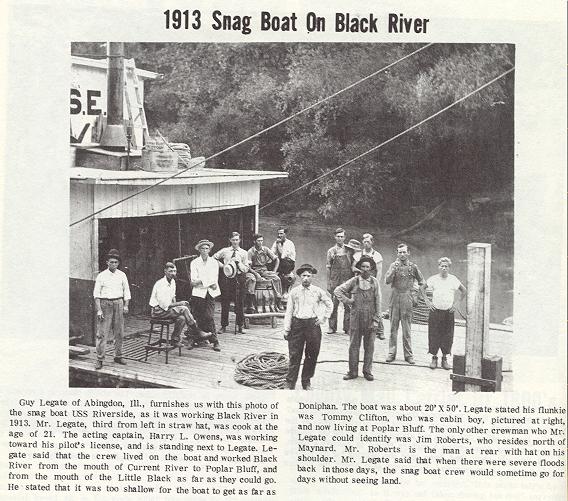
Guy Legate of Abingdon, Ill., furnishes us with this photo of the
snag boat USS Riverside, as it was working black River in
1913. Mr. Legate, third from left in straw hat, was cook at
the age of 21. The acting captain, Harry L. Owens, was
working toward his pilot's license, and is standing next to
Legate. Legate said that the crew lived on the boat and
worked Black River from the mouth of Current River to Poplar
Bluff, and from the mouth of the Little Black as far as they
could go. He stated that it was too shallow for the boat to
get as far as Doniphan. The boat was about 20' by
50'. Legate stated his flunkie was Tommy Clifton, who was
cabin boy, pictured at right, and now living at Poplar
Bluff. The only other crewmean who Mr. Legate could
identify was Jim Roberts, who resides north of Maynard. Mr.
Roberts is the man at rear with hat on his shoulder. Mr.
Legate said that when there were severe floods back in those
days, the snag boat crew would sometime go for days without
seeing land.

Black and Current Rivers were at one time a primary source of
freight hauling, as is evidenced by this photo of the barge,
"George W. Decker", which is loaded with some 300 bales
of cotton which were produced in Cherokee Bay about 1894 and had
been ginned on a tread mill gin. The photo is the property
of Mrs. E. C. Cox., Sr., of Pocahontas, whose father, the late
Harry Hite of Biggers, as a young man helped gin and load this
cotton at Sims Landing on Current River, near the Brumley farm
which now is the property of Charles A. Grier of
Pocahontas. Close scrutiny of the crew at left above, shows
men and youths, and standing to their right re apparently buyers
in black suits and derby hats worn at rakish angles, and there
are at least 3 women standing in the vicinity of the smokestacks
of the barge. A drive is now underway in Pocahontas to have
dredging resumed on Black and Current Rivers in hopes that if
river channels are widened and deepened, farm products might
again be moved from Randolph County via river.
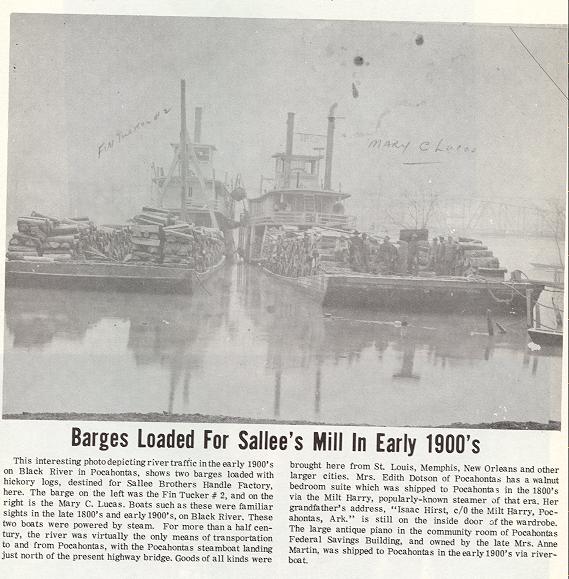
This interesting photo depicting river traffic in the early
1900's on Black River in Pocahontas, shows two barges loaded with
hickory logs, destined for Sallee Brothers Handle Factory,
here. The barge on the left was the Fin Tucker #2, and on
the right is the Mary C. Lucas. Boats such as these were
familiar sights in the late 1800's and early 1900's, on Black
River. These two boats were powered by steam. For
more than a half century, the river was virtually the only means
of transportation to and from Pocahontas, with the Pocahontas
steamboat landing just north of the present highway bridge.
Goods of all kinds were brought here from St. Louis, Memphis, New
Orleans and other larger cities. Mrs. Edith Dotson of
Pocahontas has a walnut bedroom suit which was shipped to
Pocahontas in the 1800's via the Milt Harry, popularly-known
steamer of that era,. Her grandfather's address,
"Isaac Hirst, c/o the Milt Harry, Pocahontas, Ark." is
still on the inside door of the wardrobe. The large antique
piano in the community room of Pocahontas Federal Savings
Building, and owned by the late Mrs. Anne Martin was shipped to
Pocahontas in the early 1900's via riverboat.
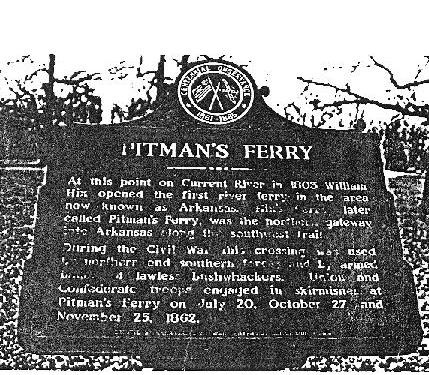
This is a picture of the marker of Pitman's Ferry. Pitman's Ferry
was the first ferry in Arkansas--it was established in 1803, and
was the equivalent of today's modern thoroughfare. It was the
gateway into Arkansas along the southwest trail, and there are
old journals that document the passage of famous people. It was
one branch of the Trail of Tears during the Cherokee Indian
removal 1837--39. During the Civil War, there was a body of
Confederate soldiers stationed here numbering 5000 strong. The
ferry was was captured back and forth during the Civil War. One
history says it was sunk when a load of Union soldiers tried to
cross during November (probably flood stage) and 20 men and 40
horses were lost. It resumed after the Civil War and sank for the
final time about 1910. The last, most infamous, tale is the story
of how the old graveyard was ravaged. In the 1930's, a man bought
the adjoining farm, and proceded to use the grave markers for the
cornerstones and foundations of his house. Some of these markers
were Civil War markers. Contributed by Cathy Johnson